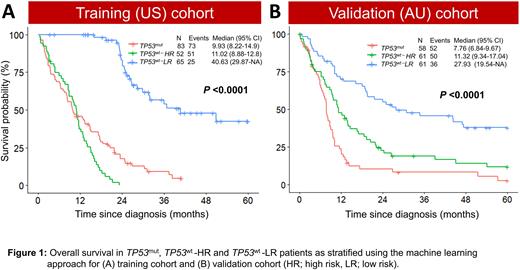Abstract
Background: Therapy-related myeloid neoplasm (t-MN), is a heterogenous entity that includes therapy-related myelodysplastic syndromes (t-MDS), myelodysplastic syndrome/myeloproliferative neoplasms (t-MDS/MPN), and acute myeloid leukemia (t-AML) phenotypes. TP53 mutations (TP53mut) are known to be associated with poor survival in myeloid neoplasms (MN), with the recently revised World Health Organization (WHO) and the International Consensus Classification recommending major changes to the MN classification based on TP53mut status. The aim of this study was to employ machine learning approach to risk-stratify t-MN using the variables available at the time of diagnosis. The secondary aim was to identify risk factors, with a focus on the TP53 wild-type (TP53wt) cohort.
Methods: We retrospectively analyzed clinicopathological features and outcomes of 380 WHO-defined t-MN patients treated at Mayo Clinic, Rochester (US cohort, n=200) or South Australia MDS Registry (AU cohort, n=180) who had cytogenetics and NGS at diagnosis. Karyotypes were classified using the International System for Cytogenetic Nomenclature Criteria. Number of cytogenetic aberrancies were counted according to Hasse et al. Leukemia 2019.
A random forest survival algorithm was used to build a prognostic model using the training cohort (US cohort). The model algorithm randomly bootstraps the original data into two thirds, where the model is developed, and one third, where the model is internally validated. The process is repeated multiple times to assure reproducibility of the final result. The model was subsequently validated in an independent cohort from South Australia. The risk score optimal cut-off was determined using the maximally selected rank statistics.
Results: The median age for the entire cohort was 67.3 (59.7-74.2) years. The most common cytogenetic abnormalities were complex karyotype (CK, 47.7%), monosomal karyotype (MK, 44.7%), deletion 7q (del 7q, 33.2%), and deletion 5q (del5q, 23.6%). Most common somatic mutations were TP53 (n=141; 37%), ASXL1 (n=67; 18%), TET2 (n=66;17%) and DNMT3A (n=64;17%), SRSF2 (n=46; 12%), RAS (44; 12%) and RUNX1 (n=43; 11%). Haematological malignancy (53.5%) followed by solid cancer (40.0%) and autoimmune disease (3%) were the most common primary diseases. Despite differences in frequency of CK, MK, del 7q and 5q between the training and validation cohort, the median overall survival (OS) was not significantly different between the US and the AU cohorts (17 vs. 11 months, P=0.51).
The US cohort was used to build a new prognostic model. A total of 88 variables available at t-MN diagnosis (15 clinical, 32 mutations, and 44 cytogenetic) were included. TP53mut was the most important variable driving poor survival. Other variables included absolute neutrophil count, number of chromosomal abnormalities, chromosome 18 abnormality, del 5q, platelets, the number of cytogenetic clones and hemoglobin. The concordance index of the model in the training cohort was 0.65.
In the US cohort, 83 (41%) and 117 (58%) patients were TP53mut and TP53wt, respectively. Median survival for TP53mut patients was 9.9 months (Figure 1A). Within the TP53wt subcohort, the model designated 52 (44%) and 65 (56%) patients as high- and low-risk groups, respectively. Strikingly, the survival of high-risk TP53wt patients was comparable to TP53mut cohort, and significantly inferior compared to the low-risk group (11.1 vs. 40.6; P<0.0001).
These results were validated in the AU cohort: the proportion of TP53mut, high-risk TP53wt, and low-risk TP53wt patients was 58 (32.2%), 61 (33.9%), and 61 (33.9%), respectively. Median survival of the 3 cohorts was 7.8 months, 11.3 months, and 27.9 months respectively (P<0.0001, Figure 1B). The c-index for AU cohort was 0.66.
Conclusion: The integrated prognostic model that used only diagnostic information, stratified t-MN patients into 3 approximately equal categories: TP53mut, constituting a third of the cohort, was the principal driver for inferior survival. Importantly, TP53wt cohort could further be stratified into 2 halves: the high-risk TP53wt patients had survival comparable to TP53mut cohort, whereas the low-risk cohort had an estimated 5-year survival approaching 45%.
Disclosures
Shah:Astellas: Research Funding; Celgene: Research Funding; Marker Therapeutics: Research Funding. Al-Kali:Astex: Other: research support to institution. Litzow:Abbvie: Research Funding; Amgen: Research Funding; Astellas: Research Funding; Novartis: Research Funding; Syndax: Research Funding; Jazz: Consultancy; Actinium: Research Funding; Pluristem: Research Funding; Biosight: Other: Data Monitoring Board. Mangaonkar:Bristol Myers Squibb: Research Funding. Patnaik:Kura Oncology, Stem Line Pharmaceuticals: Research Funding. Shanmuganathan:Novartis: Honoraria; Amgen: Other: Meeting sponsorship. Hiwase:BMS: Consultancy, Membership on an entity's Board of Directors or advisory committees, Speakers Bureau; Novartis: Speakers Bureau; AbbVie: Speakers Bureau.
Author notes
Asterisk with author names denotes non-ASH members.


This feature is available to Subscribers Only
Sign In or Create an Account Close Modal